Wednesday, July 05, 2006
Tuesday, July 04, 2006
Sunday, July 02, 2006
STRIKES
Strikes are unarmed individual hitting techniques. Strikes use hands, elbows, knees, feet and, in some instances, other parts of the body as personal weapons. You must know how to counter strikes from an opponent.
1. Punches
Punches may be thrown during any hand-to-hand confrontation. Most people resort to punching because it is a natural reaction to a threat. The purpose of a punch is to stain the opponent or to set him up for a follow-up finishing technique. However, Punches should only be executed to the soft tissue areas of an opponent. A correctly delivered punch maximizes the damage to an opponent while minimizing the risk of injury to you.
Uppercut
The uppercut is a powerful punch originating below the opponent's line of vision. It is executed in an upward motion traveling up the centerline of the opponent's body. It is delivered in close and usually follows a preparatory strike that leaves the target area unprotected. When delivered to the chin or jaw, the uppercut can render an opponent unconscious, cause extensive damage to the neck, or sever the tongue. To execute the uppercut,
Bend the arms, rotating the palm inboard. The distance the arms bend depends on how close the opponent is.
bend depends on how close the opponent is.
Rotate the hips and shoulders forcefully toward the opponent, thrusting the fist straight up toward the opponent's chin or jaw. Contact the opponent with the first two knuckles of the fist. Retract the hand immediately.
Knife Hand
The knife hand is one of the most versatile and devastating strikes. The striking surface is the cutting edge of the hand, which is the meaty portion of the hand below the little finger extending to the top of the wrist. The Striking surface is narrow, allowing strikes on the neck between the opponent's body armor and helmet. The knife hand strike is executed from one of three angles: outside, inside, and vertical.
 Outside Knife Hand
Outside Knife Hand
Execute a knife hand by extending and joining the fingers of the right hand and placing the thumb next to the forefinger (like saluting). Retract the right hand. At the same time, rotate the right hip and right shoulder backward. Thrust the knife hand forward (horizontally) onto the opponent while rotating the right hip and shoulder forward.
Inside Knife Hand
Execute a knife hand. Bring the right hand over the left shoulder. At the same time, rotate the right shoulder forward and the left hip forward. Thrust the knife hand forward (horizontally) onto the opponent while rotating the right hip and shoulder forward and the left shoulder backward.
Vertical Knife hand
When thrown vertically, the knife and strike comes straight down in a straight line.
Elbow Strikes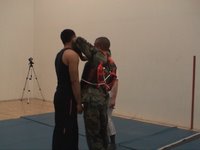
The elbow is a powerful weapon that can be used in several different ways to attack virtually any part of an opponent's body. Elbow strikes can be performed either vertically (upward or downward) or horizontally (forward or reverse). The striking surface is 2 inches above or below the point of the elbow, deputing upon the angle of attack, the opponent's attack angle, and the position of the opponent.
Vertical Elbow Strike (Up)
Bend the right elbow, keeping the fist close to the body. The fist is at shoulder level and the elbow is next to the torso. Thrust the elbow vertically upward toward the opponent while rotating the right shoulder and hip forward to generate additional power. Contact the opponent with the right forearm 2 inches above the point of the elbow.
Vertical Elbow Strike (Down)
Bend the right elbow, keeping the fist close to the body. The fist is on the shoulder and elbow is raise well above the shoulder. Thrust the elbow vertically downward toward the opponent while dropping body weight into the attack to generate additional power. Contact the opponent with the right triceps 2 inches above the point of the elbow.
Horizontal Elbow Strike (Forward)
Tuck the right fist near the chest with the palm heel facing the ground. Thrust the right elbow horizontally forward toward the opponent. The forearm is parallel to the ground. Rotate the right shoulder and hip forward to generate additional power. Contact the opponent with the right forearm 2 inches elbow the point of the elbow.
Horizontal Elbow Strike (Rear)
Tuck the right fist near the left shoulder with the palm heel facing the ground. At the same time, rotate the right shoulder forward and the left hip forward. Thrust the right elbow horizontally rearward toward the opponent. The forearm is parallel to the ground and the hand moves toward the direction of the attack. Rotate the right hip back and the right shoulder backward to generate additional power. Contact the opponent with the right triceps 2 inches above the point of the elbow.
2. Kicks
The legs are the body's most powerful weapons because they use the largest muscle groups to generate a strike. Legs are also less prone to injury. The feet are the preferred choice for striking because they are protected be boots. We use our feet, heels, and knees to execute kicks, knee strikes, and stomps.
The purpose of kick is to stop an opponent's attack or to create an opening in his defense in order to launch an attack. Kicks can be performed with the left (lead) leg or the right (rear) leg. Kicks with the rear leg have greater power because the hips are rotated into the attack. However, the rear leg is further away from the opponent so a strike with the rear leg will not contact the opponent as quickly as a strike with the lead leg.
Front Kick
The front kick is executed when the opponent is in front of you. The front kick, delivered with either the rear or lead leg, is effective for striking below the waist. Attempting to kick higher results in diminished balance and provides the enemy with a greater opportunity to grab the leg or foot. The striking surfaces are the toe of the boot or the bootlaces. To execute the front kick,
Raise the left knee waist high, pivot the hips into the attack, and thrust the left foot forward toward the opponent. Contact the opponent with the toe fo the left boot or bootlaces. Return to the basic warrior stance.
Side Kick
The side kick, delivered with the lead leg, is effective for striking the knees. The side kick is executed when the opponent is to the side of you. The striking surface is the outside cutting edge of the boot near the heel. To execute the side kick,
Raise the right knee waist high and rotate the right hip forward. Thrust the right foot to the right side toward the opponent, turning the foot at a 90-degree angle to maximize the striking surface on the opponent. Contact the opponent with the cutting edge of the right boot. Return to the basic warrior stance.
Knee Strikes
Knee strikes are excellent weapons during the close range of close combat fighting. The knee strike is generally delivered in close.
Vertical Knee Strike
The striking surface is the thigh, slightly above the knee. To execute the vertical strike,
Raise the right knee and drive it up forcefully into the opponent. Power is generated by thrusting the leg upward. Contact the opponent 2 inches above the right knee.
Horizontal Knee Strike
The horizontal knee strike is executed with the leg generally parallel tieh the ground while rotating the hips to generate power. It is often delivered the peroneal nerve. The striking surface is front of the leg, slightly above or below the knee. To execute the horizontal knee strike,
Raise the right knee, rotate the right hip forward while pivoting on the left foot, and drive the knee horizontally into the opponent. Contact the opponent 2 inchesabove the right knee.
Stomps
Stomps are delivered with the feet, usually when the opponent is down. Remember, when the opponent is down, we take whatever target is available.

Vertical Stomp
The vertical stomp allows us to remain upright and balanced, to rapidly deliver multiple blows with either foot, and to quickly and accurately attack the target. It is the preferred stomp. The striking surface is the heel. To execute the vertical stomp,
Raise the right knee above the waist with the right leg bent at approximately a 90-degree angle. Drive the flat bottom of the right boot or the cutting edge of the right heel down onto the opponent forcefully. At the same time, bend the left knee slightly to drop the body weight into the strike.

Ax stomp
The striking surface of the ax stomp is the cutting edge of the heel. To execute the ax stomp,
Raise the right heel above the waist, keeping the right leg straight. Drive the cutting edge of the right heel down onto the opponent forcefully. At the same time, bend the left knee slightly to drop the body weight into the strike.
1. Punches
Punches may be thrown during any hand-to-hand confrontation. Most people resort to punching because it is a natural reaction to a threat. The purpose of a punch is to stain the opponent or to set him up for a follow-up finishing technique. However, Punches should only be executed to the soft tissue areas of an opponent. A correctly delivered punch maximizes the damage to an opponent while minimizing the risk of injury to you.
Uppercut
The uppercut is a powerful punch originating below the opponent's line of vision. It is executed in an upward motion traveling up the centerline of the opponent's body. It is delivered in close and usually follows a preparatory strike that leaves the target area unprotected. When delivered to the chin or jaw, the uppercut can render an opponent unconscious, cause extensive damage to the neck, or sever the tongue. To execute the uppercut,
Bend the arms, rotating the palm inboard. The distance the arms
 bend depends on how close the opponent is.
bend depends on how close the opponent is.Rotate the hips and shoulders forcefully toward the opponent, thrusting the fist straight up toward the opponent's chin or jaw. Contact the opponent with the first two knuckles of the fist. Retract the hand immediately.
Knife Hand
The knife hand is one of the most versatile and devastating strikes. The striking surface is the cutting edge of the hand, which is the meaty portion of the hand below the little finger extending to the top of the wrist. The Striking surface is narrow, allowing strikes on the neck between the opponent's body armor and helmet. The knife hand strike is executed from one of three angles: outside, inside, and vertical.
 Outside Knife Hand
Outside Knife Hand Execute a knife hand by extending and joining the fingers of the right hand and placing the thumb next to the forefinger (like saluting). Retract the right hand. At the same time, rotate the right hip and right shoulder backward. Thrust the knife hand forward (horizontally) onto the opponent while rotating the right hip and shoulder forward.
Inside Knife Hand
Execute a knife hand. Bring the right hand over the left shoulder. At the same time, rotate the right shoulder forward and the left hip forward. Thrust the knife hand forward (horizontally) onto the opponent while rotating the right hip and shoulder forward and the left shoulder backward.
Vertical Knife hand
When thrown vertically, the knife and strike comes straight down in a straight line.
Elbow Strikes

The elbow is a powerful weapon that can be used in several different ways to attack virtually any part of an opponent's body. Elbow strikes can be performed either vertically (upward or downward) or horizontally (forward or reverse). The striking surface is 2 inches above or below the point of the elbow, deputing upon the angle of attack, the opponent's attack angle, and the position of the opponent.
Vertical Elbow Strike (Up)
Bend the right elbow, keeping the fist close to the body. The fist is at shoulder level and the elbow is next to the torso. Thrust the elbow vertically upward toward the opponent while rotating the right shoulder and hip forward to generate additional power. Contact the opponent with the right forearm 2 inches above the point of the elbow.
Vertical Elbow Strike (Down)
Bend the right elbow, keeping the fist close to the body. The fist is on the shoulder and elbow is raise well above the shoulder. Thrust the elbow vertically downward toward the opponent while dropping body weight into the attack to generate additional power. Contact the opponent with the right triceps 2 inches above the point of the elbow.
Horizontal Elbow Strike (Forward)
Tuck the right fist near the chest with the palm heel facing the ground. Thrust the right elbow horizontally forward toward the opponent. The forearm is parallel to the ground. Rotate the right shoulder and hip forward to generate additional power. Contact the opponent with the right forearm 2 inches elbow the point of the elbow.
Horizontal Elbow Strike (Rear)
Tuck the right fist near the left shoulder with the palm heel facing the ground. At the same time, rotate the right shoulder forward and the left hip forward. Thrust the right elbow horizontally rearward toward the opponent. The forearm is parallel to the ground and the hand moves toward the direction of the attack. Rotate the right hip back and the right shoulder backward to generate additional power. Contact the opponent with the right triceps 2 inches above the point of the elbow.
2. Kicks
The legs are the body's most powerful weapons because they use the largest muscle groups to generate a strike. Legs are also less prone to injury. The feet are the preferred choice for striking because they are protected be boots. We use our feet, heels, and knees to execute kicks, knee strikes, and stomps.
The purpose of kick is to stop an opponent's attack or to create an opening in his defense in order to launch an attack. Kicks can be performed with the left (lead) leg or the right (rear) leg. Kicks with the rear leg have greater power because the hips are rotated into the attack. However, the rear leg is further away from the opponent so a strike with the rear leg will not contact the opponent as quickly as a strike with the lead leg.
Front Kick
The front kick is executed when the opponent is in front of you. The front kick, delivered with either the rear or lead leg, is effective for striking below the waist. Attempting to kick higher results in diminished balance and provides the enemy with a greater opportunity to grab the leg or foot. The striking surfaces are the toe of the boot or the bootlaces. To execute the front kick,
Raise the left knee waist high, pivot the hips into the attack, and thrust the left foot forward toward the opponent. Contact the opponent with the toe fo the left boot or bootlaces. Return to the basic warrior stance.
Side Kick
The side kick, delivered with the lead leg, is effective for striking the knees. The side kick is executed when the opponent is to the side of you. The striking surface is the outside cutting edge of the boot near the heel. To execute the side kick,
Raise the right knee waist high and rotate the right hip forward. Thrust the right foot to the right side toward the opponent, turning the foot at a 90-degree angle to maximize the striking surface on the opponent. Contact the opponent with the cutting edge of the right boot. Return to the basic warrior stance.
Knee Strikes

Knee strikes are excellent weapons during the close range of close combat fighting. The knee strike is generally delivered in close.
Vertical Knee Strike
The striking surface is the thigh, slightly above the knee. To execute the vertical strike,
Raise the right knee and drive it up forcefully into the opponent. Power is generated by thrusting the leg upward. Contact the opponent 2 inches above the right knee.
Horizontal Knee Strike
The horizontal knee strike is executed with the leg generally parallel tieh the ground while rotating the hips to generate power. It is often delivered the peroneal nerve. The striking surface is front of the leg, slightly above or below the knee. To execute the horizontal knee strike,
Raise the right knee, rotate the right hip forward while pivoting on the left foot, and drive the knee horizontally into the opponent. Contact the opponent 2 inchesabove the right knee.
Stomps
Stomps are delivered with the feet, usually when the opponent is down. Remember, when the opponent is down, we take whatever target is available.
Vertical Stomp
The vertical stomp allows us to remain upright and balanced, to rapidly deliver multiple blows with either foot, and to quickly and accurately attack the target. It is the preferred stomp. The striking surface is the heel. To execute the vertical stomp,
Raise the right knee above the waist with the right leg bent at approximately a 90-degree angle. Drive the flat bottom of the right boot or the cutting edge of the right heel down onto the opponent forcefully. At the same time, bend the left knee slightly to drop the body weight into the strike.

Ax stomp
The striking surface of the ax stomp is the cutting edge of the heel. To execute the ax stomp,
Raise the right heel above the waist, keeping the right leg straight. Drive the cutting edge of the right heel down onto the opponent forcefully. At the same time, bend the left knee slightly to drop the body weight into the strike.

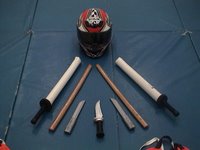
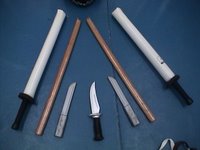
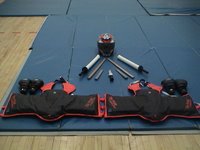
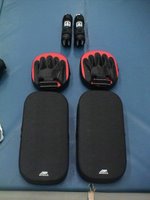
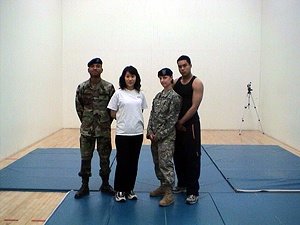
.jpg)
